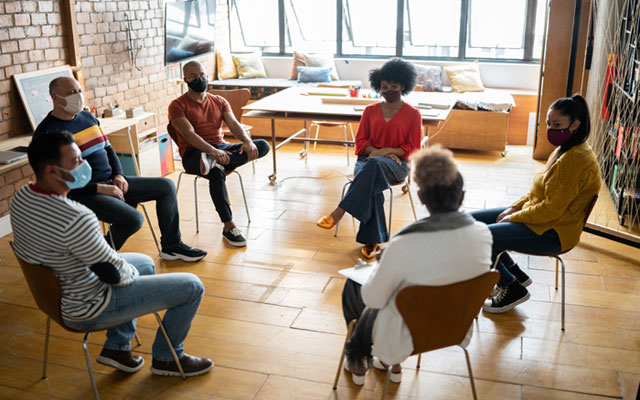Self-hypnosis is an extremely effective method of reprogramming the brain. The process is quite simple in nature, and the hardest part is figuring out exactly what you should reprogram and what you should just leave alone. Problems that aren't incredibly significant to you at the moment, or in the near future, should be left alone, unless you think it very important.
Keep in mind, no matter how many times you tweak your program, you'll never quite reach perfection. However, there isn't anything wrong with striving to continually improve yourself and your life. If you choose self-hypnosis as a method of reprogramming, you are in for a very interesting experience.
Still not getting it?
Trance is an altered state of consciousness, of relaxation, in which you feel as if you are letting go of the wheel of your life and letting something else take over. Your mind is extremely susceptible to suggestion in this state. You are conscious, but you are more of an observer.
There are all sorts of different ways to go about self-hypnotizing. It can be incredibly frustrating or incredibly easy, depending on your mindset. If you are impatient and irritated at the fact that you can't do it, you may have an extremely hard time getting into "trance."
Trance is the most critical stage of self-hypnosis. It is when you are actually receiving the programming instructions, from whatever source you may choose. The main thing about trance is that you need to hold on to your focus; keeping away from distraction is absolutely critical. Your thoughts, while in trance, are magnified significantly, so be careful and stay focused.
Before you attempt to put yourself in trance, you should have a very clear idea of what it is you hope to accomplish. Perhaps you want to instill a desire to exercise within yourself. Psyche yourself up with that, and make sure you really understand what it is you are trying to achieve, otherwise it will probably not be a successful experience.
1. Clear all thoughts - Clear any distracting thoughts from your mind. Mostly, these only serve to thwart your purpose and sidetrack you, making it impossible to enter trance. Do not, however, force these thoughts from your head. Simply don't think, and passively observe thoughts as they come. Do not go any further into them once they have popped into your head, just simply exist.
2. Relax - Relaxing every part of your body and mind is absolutely essential for self-hypnosis. It is often easier to relax yourself if you have a sort of visual breakdown of relaxing each different part of your body. Try imagining a sensation starting in your toes that melts away all tension, and slowly works its way up to your ankles, draining the tension there as well. Spend a longer time, or focus more, on relaxing parts of your body that are particularly tense. Also, make sure you completely relax your shoulders, neck, and face, as this is where a lot of tension is commonly held. Many people find it helpful to imagine a substance trickling or washing over areas with a lot of tension -- maybe warm water, or a breeze, whatever you choose. Another alternative that works for a lot of people are waves of relaxation. Try imagining waves of relaxation coming from your scalp down your body -- it can be really effective! After you get into the first stage of relaxation, it's critical to get into a second, deeper stage of relaxation. You can say to yourself, "I am so deeply relaxed," or "I am incredibly relaxed," over and over to yourself while intensifying the waves of relaxation.
3. Focus on your breathing - Don't let yourself be distracted by thoughts now. First, take notice of your breathing pattern. Adjust it to a slow, rhythmical flow that will not distract from the exercise. After your breathing is nice and slow, focus on the counts of breathing. As you exhale, mentally count to six and inhale each time you count. This is a six-count inhale. Then, after you inhale, count another six counts without exhaling. Then, exhale in six more counts. Repeat this breathing until you feel the relaxation has really settled in, and you have a pleasant feeling inside of you.
4. Begin programming - By now, you should be in a trance-like state of relaxation. Now is for the programming to begin. Whatever it is you intend to place in your mind, do it now. Make sure when you are instilling thoughts, beliefs, or patterns that they focus on the positive and not the negative. For example, instead of, "I don't want to be stressed out all the time," think "I am relaxed and happy, now, and for eternity." That way, the negative energy associated with your frustration about your stress levels cannot be translated any further. Keep in mind that this is exposing your subconscious mind, a mind that is completely different from your conscious mind. Your subconscious mind has no idea if images or statements are "real" or "true."
- After you focus on programming a pattern, habit, or belief, if you notice your head feeling tense, try to relax your body again. The deeper you go into the relaxation phase, the more effective the programming.
- It's easy to fall asleep like this, you might have to keep waking yourself up.
5. Visualize - After you finish your programming, vividly imagine you are at the top of a staircase. Take note of the stair rail, and each of the steps. Visualize yourself taking each step, carefully. When you step on the first step, mentally say "10," then on the second step mentally say, "9" and continue that process until your reach the bottom of the staircase.
Sometimes, self-hypnosis is so powerful that the effect is immediately felt upon awakening, or even during the process. This can be an extremely empowering experience, to feel that change happening within you. If you feel you have negatively impacted yourself, I suggest you repeat the steps and reverse whatever it is you think you've done wrong. Keep in mind, it will probably take a stronger dose of self-hypnotization in order to overwrite your old programming. So, once again, make sure you are careful when repeating affirmations to your mind when you are in such a vulnerable state.
If you find yourself struggling with trying to relax yourself and keep hold of your thoughts, or you simply aren't comfortable trying out self-hypnotism, you can try an easier alternative instead. There are many hypnotism MP3s available out there on the Internet -- simple audio files, windows media, or other media players can play.
Your Assignment: Your assignment is to write in your journal about hypnotists and your opinion on them. If you did decide to try self-hypnosis, or used the MP3s, feel free to write about that instead.
What exactly is visualizing?
Visualization is a mental movie rehearsing things to come.
Visualization is a unique and, many times, helpful technique used along with intention manifestation and the Law of Attraction. With a little time on your hands, you can go wherever you wish, all in your own head. You can go to a fancy hotel, an airport, Hawaii, wherever! You can place yourself in a room with someone you'd like to talk to, hold a conversation, and then simply open your eyes and go back to what you were doing. The energy created from visualization does have an impact on reality, so don't think of it as useless or futile. Besides, it's fun!
Visualization is a technique you practice every single day to some extent, whether you realize it or not. When an image of something you want or something you don't want flashes through your mind, that is a minor form of visualization. These are powerful enough to have effect in your life, but if you take control of this tool, you can accomplish a great deal more. Also, creative visualization allows you to pick and choose your destiny, instead of your destiny simply happening to you from random images and visualizations you have performed without even fully realizing it
Did you know that your subconscious mind doesn't discriminate between visualizations and actual reality? That means, you earn realexperience each time you visualize yourself practicing a certain skill or doing a certain thing. The more you visualize yourself doing these things, the better you will be when you finally attempt the skill.
Did you know that you will most likely be better at a certain skill or event simply by going over it, in detail, in your head? If you visualize yourself writing a chapter of a fantastic, ground-breaking novel every single day of one month, I guarantee you'll be a better writer for it. Try it, maybe not for a month or even a week, but do try it. Perhaps you have a task you are putting off right at this very moment. Visualize yourself doing that task, doing it very well and efficiently, and then feeling that weight being lifted off your shoulders as you complete the task. Imagine yourself feeling proud and accomplished after you have finished the task. If you have visualized the scene in vivid detail, you will probably get up after reading this section, and complete that task. Notice how much easier it seems now that you've thought yourself through the process.
Health, success, career, money, promotions, possessions, and relationships can all be greatly improved with conscious, positive, energetic visualization. Of course it may take time, or it may happen almost instantly. Either way, prepare to wait a little while, but definitely know that you will see some signs that you are moving ahead towards your vision.
Benefits of Visualization
1. Creates templates - When you are visualizing, your brain reacts by sending electrical impulses to the corresponding muscles associated with whatever is being visualized. Therefore, if you visualize shooting a basketball or running around, impulses will be sent to your muscles, and will make the actual event easier to achieve when it's time for the real thing.
2. Possibilities - When visualizing, you are often reaching outside of your normal comfort zone. You can visualize any scenario with your friends, family, colleagues, and anyone else. You can see the whole picture of your life in a new perspective, or you can simply re-create your life in a way that you wish it was.
3. Your intuition is ready and waiting - When you visualize, you reach into the confines of your mind and bring all the resources and available data for making good intuitive decisions back to the front, where they will be ready and waiting for you to activate after visualization. It makes the actual event so much easier, you will notice tremendous change in your performance every time when visualizing. Try it out for yourself!
Some people may tell you that visualizing the event is a waste of time and frivolous, but I am confident that you will change your mind once you try it for yourself and see your results. You can alter your reality and your future from the safety of your own mind -- and that is a tool no one should put to waste.
One of the most helpful techniques to execute when visualizing is recalling past successes. This literally multiplies the positive energy of the experience and rejuvenates your spirit, and gives you that extra motivation for achieving that success again. Don't worry about not feeling the effects; you will eventually, if you don't feel motivated the first time. Motivation breeds action no matter how you look at it, and visualization is an extremely powerful motivational tool.
Anxiety and Fear
Visualizing Your Worst Fear
1. Think - Think long and hard about the times you have felt most afraid in your life. What was it, exactly, that you were afraid of? Was it fear of rejection, change, failure, or success? A different, more specific fear? Once you discover your worst fears, it's time to come face to face with them and conquer them, all from the safety of your own chosen spot. Make sure the area you choose is one where you feel serene, peaceful, powerful, in control, and safe.
2. Get into the "zone" - Make sure you completely immerse yourself in the fear and emotions you were feeling at the time, but with the intention of pulling out and giving yourself strength in the process. You need to feel the fear, and then you need to use your emotions to conquer that fear.
3. Conquer - Conquer that fear. Summon up all your inner strength and know that you can handle anything. Use positivity, and turn this into a learning experience. There's more than one way you can do this, too. You can strengthen your resolve with positive affirmations, but keep in mind that your emotions have to match these affirmations. If you tell yourself that you are strong, then put some energy into. Feel your own strength. Don't just say it.
How fast you achieve your goals in life is directly related to how often and how powerfully and clearly you visualize your goals. Your visualization technique will improve greatly with regular practice, and it's really very easy to develop a habit of practicing every day when you wake up and before you go to bed. It can be really comforting to fall asleep to the image of you and your life working out exactly the way you planned it.
The difference between daydreaming and real visualization
Daydreaming can be a pleasant experience, but usually it is not powerful or clear enough to get you what you want out of your life, like creative visualization. Daydreaming is, however, the first step to powerful visualizing. Visualization is like daydreaming, except multiplied in effectiveness and power.
Keep in mind that results from visualization may not be instantaneous, but if you have patience, it will pay off. Don't let yourself fall into a habit of negative thinking or constant doubt, or you will be consumed by those things. Doubt and negativity don't sound like things you would want in your life, do they?
Make $1,000 With Visualization
Picture yourself in a bank. It may or may not be your usual bank, but the usual bank going-ons are taking place. There are people talking and making transactions. You look down at a check written out to you. The amount is $1,000. You don't know who wrote it to you, or even where you are, but you know this money is yours. The excitement wells up inside of you when you think of how you are going to spend this money. You earned it. This is happening sometime in the future. You're not quite sure how, why, where, or who, but you definitely know what. The mental image you create needs to be soaked with as much power, energy, and excitement as you can possibly muster. The better you visualize, the more likely it is that this event will occur and if you do it very well, it will probably be a lot sooner and a lot better than you expect. See yourself depositing the money into the bank, and looking over the statement. Feel the security and pride of having plenty of money in the bank.
Your results with this exercise may be delayed or immediate. Your reward may come in many different forms, there is no way to know exactly when and how it will appear, so you probably shouldn't try unless the way you get the money is also important to you.
Changing Your Day-to-Day With Visualization
Visualization is an awesome tool for creating spontaneous success, but it can also be used to make your everyday existence a lot more enjoyable. You simply have to know what you want out of your everyday life and visualize it powerfully and exactly.
When you successfully implement visualization into your daily tasks, the flow of everything becomes much easier and you spend a smaller amount of energy for better results. Normally, without conscious visualization, it is somewhat of a random chance that we like our daily lives. Maybe you do, and maybe you think you could use a big change, and as quick as possible. If your daily life is lackluster, the first step is to realize that right now and decide to do something about it with visualization.
Ask yourself what sort of things you would really enjoy doing every single day for a moderate to long period of time. What skills and hobbies would you like to frequently train or indulge in? Which people would you like to see and interact with on a daily basis? Do you want security and predictability, or do you want spontaneous events happening at all times during your life? Visualizing the day in great detail and with powerful energy in the morning has a profound affect on your day. Many times when you are visualizing yourself doing tasks you do every day with maximum efficiency and speed, many other good things come out of it as well. For example, say you visualize yourself with great energy, completing a series of tasks within half an hour. You may finish in 20 minutes, and then decide to start working on a project you've been meaning to get around to. After you get started, maybe you'll decide your work is coming too naturally to just quit, and get an enormous amount more done than you'd previously hoped. Such is the power of visualization.






























